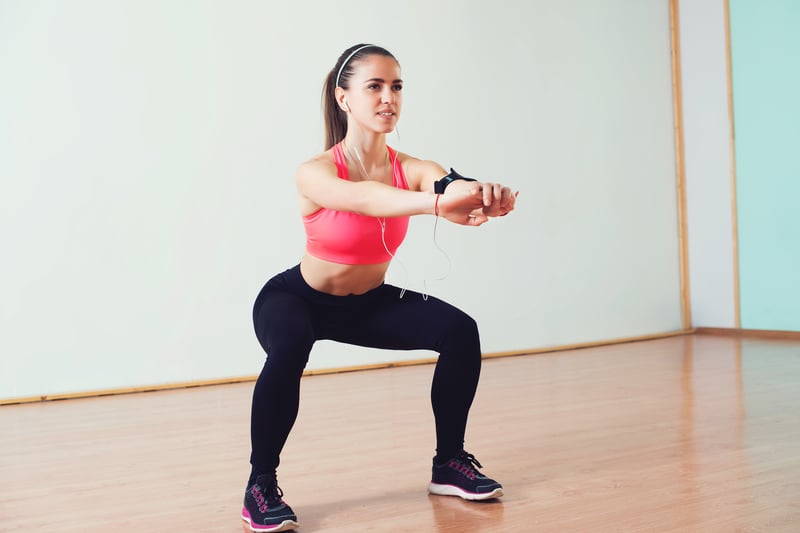How to Improve Your Squat Form + 5 Variations You Should Try

You’ve heard squats are a great exercise for your whole body, especially those legs and glutes that you’ve been trying so hard to shape. So, you’re ready to start squatting and/or want to learn how to improve your squat so you can get all of the benefits without getting injured. Well, right here and now, you can learn more about squatting, the many benefits thereof, and how, exactly, to do a squat the right way.
What is a Squat?
You’ve undoubtedly heard of the exercise called the squat, but maybe you’re not entirely sure what that means. A “squat” is a fundamental exercise that engages many of the muscles in the body, burns copious amounts of calories, and significantly helps to tone and shape your lower body.
A squat is what’s known as a “compound movement.” This is a movement that involves using multiple muscles at the same time to perform it correctly. A squat is considered a compound exercise because it recruits many of the muscles in the lower body such as the quadriceps (front of the thighs), glute muscles (in the butt), hamstrings (back of the legs), and hips.
What are the Benefits of Squat Exercises?
Squats are an amazing exercise that should be learned and used on a regular basis as part of a well-rounded fitness regimen. Here are a few of the numerous benefits:
- Shape your legs and glutes—not only do squats radically help trim and tone your lower body, they can help add that sexy sweep to the thighs and hamstrings and raise the glutes (i.e., lift up the butt!).
- Build muscle—squatting as part of a regular fitness program can help you build muscle throughout your body. Because they are an intense compound movement, both growth hormone and testosterone are released, which makes building extra muscle easier for you across the board.
- Burn extra fat—not only are squats famous for incinerating calories, but the additional muscle you build will permanently ramp up your metabolism, allowing you to burn off extra calories 24/7.
How to Properly Perform a Squat
Remember, using proper form is essential with any type of exercise but especially when performing squats. It’s important to make sure you’re fully warmed up before starting your squat routine. Start with walking, a gentle jog, or other leg exercises until you feel sufficiently warmed up.
When you’re ready to start, stand with your feet about hip-width apart or slightly wider. You can also point your toes slightly out to the sides. You’ll want to keep your knees above your ankles and in line with your feet throughout the movement. That is, avoid letting your knees jut in front of your feet, which can add too much stress to your knees and ankles, putting you at risk for an injury.
Hold onto a barbell with your palms facing forward and your hands placed a comfortable width on the bar (usually just above your elbows). Begin with the bar on your upper back (right on the trap muscles behind your neck—never directly on your spine). Keep your head facing forward, push your hips back, and bend at the knees to lower your body until you are in a squat position.
Make an effort to stop when your thighs are parallel to the ground, and again, try not to let your knees float forward past your toes. You’ll also want to ensure your knees travel the same direction your feet are pointed (so that everything stays aligned).
Also, make sure to keep your chest up and out and your torso as upright as possible throughout the movement. You can make this easier on yourself by fixating on something above you during the exercise. This will naturally help you keep your chest and head high and upright.
When you reach the parallel “squat” position (you’ll look like you’re about to sit down except there is no chair), you can pause for a moment, and then push through your heels to return to your starting position.
How Not to Do a Squat (Improve Your Squat by Not Doing This!)
While you may think you understand how to do a squat, it can also be important to understand some common pitfalls, so you can avoid them. If you want to improve your squat form and get the most benefits from this amazing exercise, be aware of the following and avoid them:
- Not warming up
- Not wearing flat shoes (wear flat shoes or even take off your shoes when squatting)
- Bouncing at the bottom of the movement (instead of controlling the weight at all times)
- Balancing on your toes (your weight should be over your heels)
- Allowing your feet and knees to move in different directions
- Rolling your feet or ankles in or out to the sides (your knees should track over your feet)
- Letting your knees move inward as you push back up to a standing position
- Not squatting down far enough
- Tilting your chest/torso so you lean forward (you want to remain upright)
- Not keeping the movement of the bar in a straight line (from the side view)
Try These 5 Squat Variations
Parallel squats with your feet hip-width apart (or slightly wider) and facing forward are the most common. But, you can expand your horizons and improve your squat form by employing a few great squat variations.
1. Bodyweight squats—this old standby can be done literally anywhere as it requires only your body. Simply stand and place your hands where they are comfortable (for example, on your head, on your hips, or clasped in front of you). Perform a squat as instructed above.
2. Wide-stance squats—as the moniker suggests, simply adjust your stance so your feet are well past hip-width apart. While still taxing the quadriceps muscles, a wider stance will also focus on activating your glutes.
3. Goblet squats—similar to wide-stance squats, hold a kettlebell or a dumbbell in both hands in front of you and point your feet and knees out to the sides. Squat down as you usually would but go into a deeper squat with your elbows on the insides of your knees. Return to the starting position by pushing upward through your heels.
4. Side squats—try these without weight. Begin by standing with your feet hip-width apart and your hands pressed together in front of you. Take a giant step to your right with your right foot (ensure your foot faces forward) and squat down until your thighs are parallel to the ground. Push up through your heels and return the right leg to the starting position. Repeat on the left side.
5. One and a half squats—this is a simple, effective squat variation that can help you build up strength and tighten up your form. Do a normal squat (or any of the above versions). Go all the way to the bottom of your squat position and then begin to straighten your legs. When you are halfway back up to the start position, pause, hold and return to the bottom portion of your squat. Next, power through your heels to return to the start to complete one full repetition.
Any of these squat variations will help you develop a stronger, tighter lower body and help improve your performance in just about any activity. They’re one of the foundation exercises that virtually all of us should do every week. As the old saying goes, “Friends don’t let friends skip leg day!”






